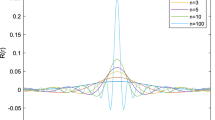Abstract
A scheme for dealing with the quantum three-body problem is presented to separate the rotational degrees of freedom completely from the internal ones. In this method, the three-body Schrodinger equation is reduced to a system of coupled partial differential equations, depending only upon three internal variables. For arbitrary total orbital angular momentum / and the parity (− 1)l+λ (λ = 0 or 1), the number of the equations in this system isl = 1 −λ. By expanding the wavefunction with respect to a complete set of orthonormal basis functions, the system of equations is further reduced to a system of linear algebraic equations.
Similar content being viewed by others
References
Delves, L. M., Tertiary and general-order collisions, Nucl. Phys., 1959, 9(3):391.
Delves, L. M., Tertiary and general-order collisions (II), Nucl. Phys., 1960, 20(2):275.
Smith, F. T., A symmetric representation for three-body problems,.J. Math. Phys., 1962, 3(4):735.
Smith, F. T., Generalized angular momentum in many-body collisions, Phys. Rev., 1960, 120(3):1058.
Krivec, K., Hyperspherical-harmonies methods for few-body problems, Few-Body Systems, 1998, 25:199.
Fano, U., Green, D., Bohn, J. L. et al., Geometry and symmetries of multi- particle systems, J. Phys. B, 1999, 32(6): R1.
Haftel, M. I., Mandelzweig, V. B., Fast convergent hyperspherical harmonic expansion for three-body systems, Ann. Phys. (NY), 1989, 189(1):29.
Giocobiano, E., Biruben, F., Energy level measurements and Lamb shift in helium, J. Phys. B., 1982, 15(2):1385.
Juncar, P., Berry, H. G., Damashini, R. et al., Energies of some triplet levels in+ He I, J. Phys. B, 1983, 16(3): 381.
Hlousek, L., Lee, S. A., Fairbank, W. M., Precision wave length measurements and new experimental Lamb shifts in helium, Phys. Rev. Lett., 1983, 50(5):328.
Sansonetti, C. J., Martin, W. C., Accurate wave-number measurements for the4He I 1s 2p-ls 3d transitions and comparisons of several term separations with theory, Phys. Rev. A, 1984, 29(1):159.
Radzig, A. A., Smirnov, B. M., Reference Data on Atoms, Molecules, and Ions, Berlin:Springer-Verlag, 1985.
Freund, D. E., Huxtable, B. D., Morgan III, J. D., Variational calculations on the helium isoelectronic sequence, Phys. Rev. A, 1984, 29(2):980.
Haftel, M. I., Mandelzweig, V. B., A fast convergent hyperspherical expansion for the helium gruund state, Phys. Lett. A, 1987, 120(5):232.
Haftel, M. I., Mandelzweig, V. B., Correlation-function hyperspherical harmonic calculations of theppμ,ddμ, andttμ molecular ions, Phys. Rev. A, 41(5):2339.
Krivec, R., Mandelzweig, V. B., Matrix elements of potentials in the correlation-function hyperspherical-harmonic method, Phys. Rev. A, 1990, 42(7):3779.
Mandelzweig, V. B., Hyperspherical approach to few body problems:A sum- and new developments, Nucl. Phys. A, 1990, 508:63c.
Barnea, N., Mandelzweig, V. B., Matrix elements of potentials forL = 1 hyperspherical states, Phys. Rev. A, 1990, 41 (9):5209.
Barnea, N., Mandelzweig, V. B., Matrix elements between vector hyperspherical states, Phys. Rev. A, 1991, 44(11): 7053.
Berkovic, S., Krivec, R., Mandelzweig, V.et a1., Hyperspherical approach to the calculation of few-body atomic resonances, Phys. Rev. A, 1997, 55(2):988.
Lin, C. D., Doubly excited states, including new classification schemes, Adv. At. Ma1. Phys., 1986, 22:77.
Tang, J. Z., Watanabe, S., Matsuzawa, M., General computational method for two-electron systems, Phys. Rev. A., 1992, 46:2437.
Zhou, B., Lin, C. D., Tang, J. Z. et a1., A hyperspherical close- coupling calculation of photoionization from the He atom, Li+ and C4+ ions (I)—Below theN = 2 threshold, J. Phys. B, 1993, 26(16):2555.
Zhou, B., Lin, C. D., A hyperspherical close-coupling calculation of photoionization from the He atom, Li+ and C04+ ions (II)—Between theN = 2 andN = 3 thresholds, J. Phys. B, 1993, 26(16):2575.
Heim, T. A., Amen, G. B., Rau, A. R. P., Pair-Rydberg description of doubly excited states:Diabatic evolution of correlation patterns, Phys. Rev. A, 1997, 55(4):2674.
Fabre de la Ripelle, M., Haftel, M. I., Larsen, S. Y., Potential-harmonic expansion for atomic wave functions, Phys. Rev. A, 1991, 44(11):7084.
Feagin, J. M., Macek, J., Starace, A. F., Use of the Fock expansion for1 S-state wave functions of two-electron atoms and ions, Phys. Rev. A, 1985, 32(6):3219.
Ho, Y. K.,P-wave doubly excited resonances in He, J. Phys. B, 1982, 15(19):L691.
Ho, Y. K., Doubly excited1 S e resonance states of helium atoms below theN hydrogenic thresholds withN ⪯ 6, Phys. Rev. A, 1986, 34(5):4402.
Yan, J., Qu, Y. Z., Voky, L. et al., Polarization effect on He doubly excited states below theN = 2 threshold of He+, Phys. Rev. A., 1998, 57(2):997.
Selles, P., Mazeau, J., Huetz, A., Wannier theory for Po andD e states of two electrons, J. Phys. B, 1987, 20(19): 5183.
Heim, T. A., Green, D., Alternative sets of hyperspherical harmonic:Satisfying cusp conditions through frame transformations, J. Math. Phys., 1999, 40(4):2162.
Viviani, M., Transformation coefficients of hyperspherical harmonic functions of anA-body system. Few-Body Systems, 1998, 25:177.
Wigner, E. P., Group Theory and its Application to the Quantum Mechanics of Atomic Spectra, New York:Academic Press, 1959.
Edmonds, A. R., Angular Momentum in Quantum Mechanics, Princeton: Princeton University Press, 1957.
Author information
Authors and Affiliations
Corresponding author
Rights and permissions
About this article
Cite this article
Ma, Z. Quantum three-body problems. Sci. China Ser. A-Math. 43, 1093–1107 (2000). https://doi.org/10.1007/BF02898245
Received:
Issue Date:
DOI: https://doi.org/10.1007/BF02898245



